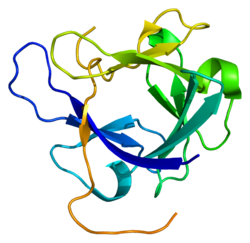
FGF19

1PWA, 2P23996514170ENSG00000162344ENSMUSG00000031073O95750O35622NM_005117NM_008003NP_005108NP_032029Fibroblast growth factor 19 is a protein that in humans is encoded by the FGF19 gene. It functions as a hormone, regulating bile acid synthesis, with effects on glucose and lipid metabolism. Reduced synthesis, and blood levels, may be a factor in chronic bile acid diarrhea and in certain metabolic disorders.1pwa: Crystal structure of Fibroblast Growth Factor 192p23: Crystal structure of human FGF19 Fibroblast growth factor 19 is a protein that in humans is encoded by the FGF19 gene. It functions as a hormone, regulating bile acid synthesis, with effects on glucose and lipid metabolism. Reduced synthesis, and blood levels, may be a factor in chronic bile acid diarrhea and in certain metabolic disorders. The protein encoded by this gene is a member of the fibroblast growth factor (FGF) family. FGF family members possess broad mitogenic and cell survival activities, and are involved in a variety of biological processes including embryonic development cell growth, morphogenesis, tissue repair, tumor growth and invasion. This growth factor is a high affinity, heparin dependent ligand for FGFR4. Expression of this gene was detected only in fetal but not adult brain tissue. Synergistic interaction of the chick homolog and Wnt-8c has been shown to be required for initiation of inner ear development. The orthologous protein in mouse is FGF15, which shares about 50% amino acid identity and has similar functions. Together they are often referred to as FGF15/19. FGF19 has important roles as a hormone produced in the ileum in response to bile acid absorption. Bile acids bind to the farnesoid X receptor (FXR), stimulating FGF19 transcription. Several FXR / bile acid response elements have been identified in the FGF19 gene. Human FGF19 transcripts have been shown to be stimulated approximately 300-fold by physiological concentrations of bile acids including chenodeoxycholic acid, glycochenodeoxycholic acid and obeticholic acid in explants of ileal mucosa. FGF19 regulates new bile acid synthesis, acting through the FGFR4/Klotho-β receptor complexes in the liver to inhibit CYP7A1. FGF19 also has metabolic effects, affecting glucose and lipid metabolism when used in experimental mouse models. When FGF19 was inhibited by specific anti-FGF19 antibodies in monkeys, severe diarrhea was the result. There was also evidence of liver toxicity. Increases in bile acid synthesis, serum and fecal total bile acids, and specific bile acid transporters were found. Patients with chronic diarrhea due to bile acid malabsorption have been shown to have reduced fasting FGF19. Surgical resection of the ileum (as often occurs in Crohn's disease) will reduce bile acid absorption and remove the stimulus for FGF19 production. In primary bile acid diarrhea, absorption of bile acids is usually normal, but defective FGF19 production can produce excessive bile acid synthesis, as shown by increased levels of 7α-hydroxy-4-cholesten-3-one, and excessive bile acid fecal loss, indicated by reduced SeHCAT retention. This was confirmed in a prospective study of patients with chronic diarrhea, where the predictive value for FGF19 in diagnosis of primary bile acid diarrhea and response to bile acid sequestrants was demonstrated.
